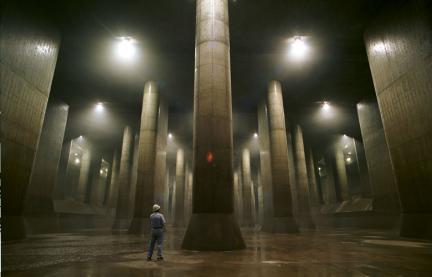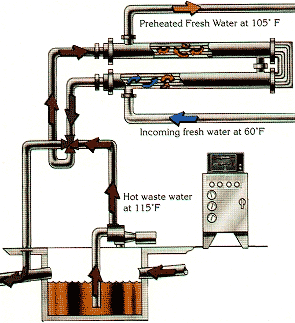1006 Morton Street
Baltimore, MD 21201
410.576.9131 | RW1haWw=
December 5 2007
2010 Olympic Village Using Sewage-Heat Recovery
After looking at a number of alternatives, the city of Vancouver chose to follow the example set by the city of Oslo, Norway and will implement North America's first sewer heat recovery system for the 2010 winter games. It is scheduled to be completed in 2009.
An enormous amount of thermal energy is lost when the liquid effluent from wastewater treatment plants is discharged to surface water bodies. Existing sewer heat recovery technologies are available to capture this wasted energy and put it to productive use to heat and cool buildings or to provide domestic hot water. European cities set a fine example: Oslo's project taps heat from raw sewage using large machines at the end of a 984 ft (300 m) tunnel that draw heat from the sewer and transfer it to a network of hot water pipes feeding thousands of radiators and taps around the city. The heat pump, a system of compressors and condensers, produces 18 MW, enough to heat 9,000 homes. In another project, a bigger heat pump in Sweden with a 160 MW capacity obtained heat from treated sewage. In Finland, a 90 MW heating plant run on wastewater. See more at Reuters.
Like geothermal systems that use heat exchangers to extract heat from the soil, sewer heat recovery extracts heat from, well you get the picture. The ideas here are not new. Sewer-heat recovery systems use exchangers to extract the otherwise waste heat from liquid effluent and use it to generate heat for buildings or domestic hot water use. Waste heat recovery seems to have excellent potential to help reduce energy consumption.
By some estimations, it's proper implementation can reduce the thermal energy used for generating hot water by 50% and with the help of a solar thermal water heating system, just think of the possibilities. Some systems pre-heat incoming domestic water before it reaches the boiler thereby reducing the delta T and the need for much natural gas or propane augmentation.
Here's a great diagram of one type of system:
This technology has been grossly underutilized; sewer heat represents an untapped source of wasted energy.
The title image is actually a sewer in Japan...
Recent Posts
Reimagining Harborplace to Create Space for Both Private Development and Expanded Public Space » Lawyer's Mall Reconstruction Progress » Confronting the Conventions of Customary Practice » Reconceived Facades: New Roles for Old Buildings » Ivy Bookshop Opens for Business! »
Categories
Yellow Balloon Baltimore » Products + Technology » Industry + Practice » Other » Architecture »
Links
Organizations
- USGBC Baltimore Regional Chapter »
- AIA - American Institute of Architects »
- USGBC »
- The Walters Art Museum »
- Green-e »
- Center for Building Performance and Diagnostics (CMU) »
- Green Globes »
- Prefab Lab (UT) »
- Center for Sustainable Development (UT) »
- Architecture 2030 »
- Bioneers »
- Street Films »
- FreeCycle »
- Chesapeake Bay Foundation »
- Archinect »
- BD Online - The Architects Website »
- National Wildlife Foundation »
- Natural Resources Defense Council »
- Overbrook Foundation »
- Merck Family Foundation »
- Ecology Center »
- New Building Institute »
- Neighborhood Design Center »
- The Leonardo Academy »
- ZigerSnead Architects LLP »
- The Rocky Mountain Institute »
- Urban Habitats »
- ACORE - American Council on Renewable Energy »
- Parks and People Foundation of Baltimore »
- Open Society Institute of Baltimore »
- Natural Capital Institute »
- Passive House US »
- Svanen Miljomark »
- Green Restaurant Association »
- Rocky Mountain Institute »
- Green Exhibits »
- Green Roundtable »
- John Elkington - SustainAbility »
- SustainAbility »
- Building America »
- Endangered Species Program - Fish and Wildlife Service »
- Congress for the New Urbanism »
- Urban Land Institute »
- Cool Roof Rating Council »
- Montgomery County (MD) Public Schools Green Building Program »
- National Institute of Standards and Technology Software »
- Scientific Certification Systems »
- Community Greens »
- CBECS »
- CASE - Center for Architecture Science and Ecology »
Interesting Sites
- The Ecologist »
- Treehugger »
- Grist »
- WIRED »
- Planet Architecture »
- MiljoBloggAktuellt - Environmental News Blog (Swedish »
- Sustainable Design Update »
- Eikongraphia »
- World Architecture News »
- The Cool Hunter »
- Design Center »
- ZEDfactory »
- Architen Landrell Associates Ltd. »
- Environmental Graffiti »
- businessGreen »
- Best Green Blogs Directory »
- Groovy Green »
- EcoGeek »
- Urban Ecology »
- Locus Architecture »
- Urbanite »
- A Daily Dose of Architecture »
- Adaptive Reuse »
- Audacious Ideas »
- Big Green Me »
- NOTCOT »
- Sustainable Baltimore »
- Thoughts on Global Warming »
- Green Maven »
- WorldChanging »
- Go For Change »
- Building Green »
- Home Energy Magazine »
- Home Energy Blog »
- FEMA Map Service- Federal Emergency Management Association »
- Architectural Graphic Standards »
- E-Wire »
- Post Carbon Cities »
- Alt Dot Energy »
- Whole Building Design Guide »
- B'more Green »
- EJP: Environmental Justice Partnership »
- Baltidome »
- OneOffMag »


December 6th, 2007 at 3:41 PM
fredscharmen
That image above is actually a stormwater overflow tank, not a sewer, but it is in Tokyo. It's called G-CANS, and it's one of the largest public works projects in the world. There are more pictures here: link (that site's all in Japanese, but it's worth clicking around, the images are amazing, and somewhere in there is a really cool animation showing how it all works)